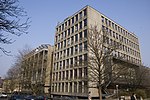The Victoria, Bristol
Buildings and structures in Clifton, BristolCommercial buildings completed in 1850Grade II* listed pubs in BristolUse British English from February 2023

The Victoria (grid reference ST576735) is a public house dating from 1867. It was built using part of the front building of The Lido, Bristol. Inside there are two rooms and an original 19th century fireplace, with the remainder of fixtures and fittings replaced more recently. The Victoria was designated Grade II* listed building status in 1998.
Excerpt from the Wikipedia article The Victoria, Bristol (License: CC BY-SA 3.0, Authors, Images).The Victoria, Bristol
Saint Pauls Road, Bristol Clifton Village
Geographical coordinates (GPS) Address Nearby Places Show on map
Geographical coordinates (GPS)
| Latitude | Longitude |
|---|---|
| N 51.4589 ° | E -2.6117 ° |
Address
Saint Pauls Road 48
BS8 1RY Bristol, Clifton Village
England, United Kingdom
Open on Google Maps








